When we began planning this trip in the summer of 2015, the airlines were reducing the value of frequent flyer miles and making it much harder to get reward tickets. We decided to use up a chunk of Jim's miles for business class fares to and from our destination. United came through with the tickets, but the routings were not exactly direct. On the way out we flew Ethiopian Airlines with a change of planes in Addis Ababa. On the way back we flew Swiss with two changes in Zurich and Brussels.
Our first challenge with Ethiopian was getting seats assigned. Jim couldn't get it done using their web site. We cruised by the Ethiopian desk every time we visited Dulles, but they are only staffed when the daily flight is scheduled and we were never there at the right time. United was no help. It took three or four phone calls, but he finally got us seats together.
The next challenge was getting boarding passes. Jim always prints them out as soon as the airline allows, but the Ethiopian web site continued intractable. Another phone call revealed that this is a common occurrence, and we would just have to pick them up at the airport. As it happened, there was no problem and we were ready to fly bright and early on the morning of 28 November. The flight was pleasant with wonderful food. I tried an Ethiopian wine made from honey and hops. It was interesting. 'Nuff said. Jim enjoyed the Ethiopian beer. The airport at Addis Ababa was comfortable although a lot of it was closed for construction. The flight from Addis to Dubai, on the other hand, was another challenge. There was a "minor technical problem" with one of the engines. It was fixed after a two-hour delay. A direct route to Dubai would take us over Yemen and Saudi Arabia, who are at war with each other, so we were delighted that the actual route took us along the Gulf of Aden. We didn't turn inland toward Dubai until we reached Omani air space.
Dubai is the most populous city of the United Arab Emirates (UAE) and the start of our journey. It also has the most extensive airline service, so it was the easiest to get to! The airport was our first introduction to "expats." Only 15% or so of the population of the UAE are Emiratis. The others are expatriates, NOT immigrants, from a wide variety of nations, but primarily from Pakistan, India and Bangladesh. We were met at the airport by a young Filipino woman, whose job was escorting tourists through baggage claim, immigration and customs. She snared us a porter (also an expat) who corralled our luggage and took us to meet the designated driver, from India, who would take us to the hotel. The driver had lived in Dubai for five years and was not looking forward to the day when he would have to return to his home country. Expats can only stay while they have jobs and are required to leave when they turn 60. In 2019, On May 21, 2019, a "Golden Card" program provided permanent residency to "prominent investors, scientists, engineers and other talented people who have already made a considerable contribution to the country." Taxi drivers need not apply.
Since returning from the trip I have done research on expats and have found an organization, InterNations, that maintains information on expat-friendly locations. In general the Gulf states do not rank high (although Bahrain & Oman outrank the USA). In 2016 the UAE ranked 40 out of 67.
We chose to include a one-day pre-trip extension that gave us an opportunity to visit "old town" Dubai. We enjoyed it much more than the glitz and glam of the new Dubai, which feels like a cross between Las Vegas and Disneyland.
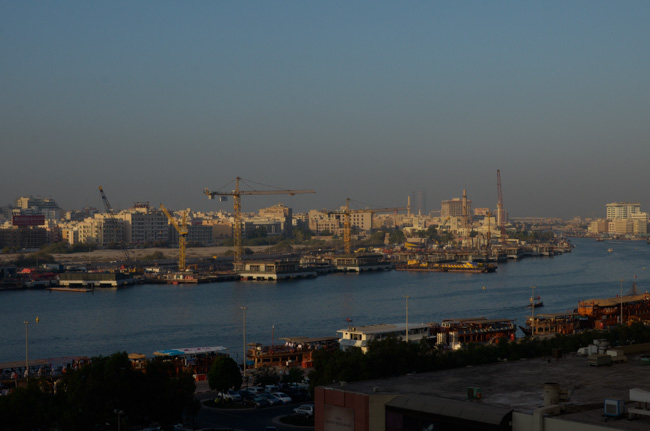
Our hotel overlooked the Dubai creek. This waterway attracted settlement in ancient times, but there was never a large population until fairly recently.
The boats docked on our side of the creek are dhows that offer dinner cruises. As we walked along the corniche in the evening, representatives of the various boats enthusiastically solicited our custom. We resisted.
"Corniche" was a new word to me. According to the dictionary it means a road along the water, typically on a cliff. We didn't see any cliffs on our travels, but the roads along the water in the various ports were all called "corniche."
The area on the far side of the creek is the old modern downtown Dubai.
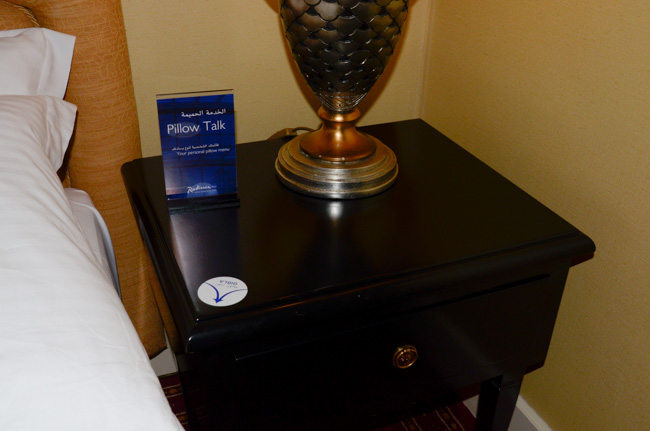
This is a sight you don't see in a hotel bedroom back home. The sticker indicates the location of Mecca -- the qibla. We were not surprised that there was no Gideon Bible. The qibla indicator in other hotels was not as prominent -- once we found it inside a drawer.
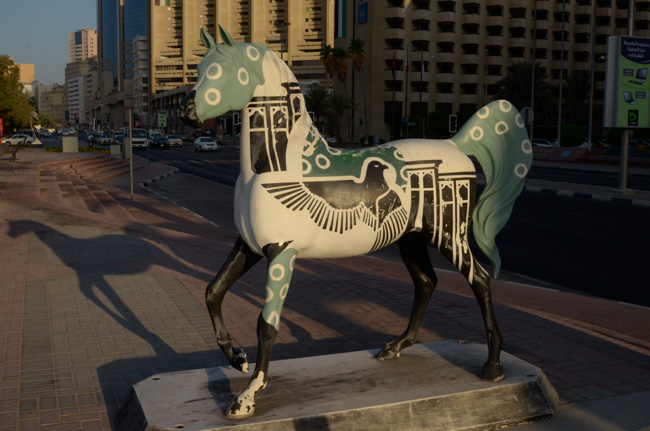
The park across the street from the hotel had this "painted pony" -- obviously an Arabian horse. There were also a plaster falcon and a camel with similar decorations.
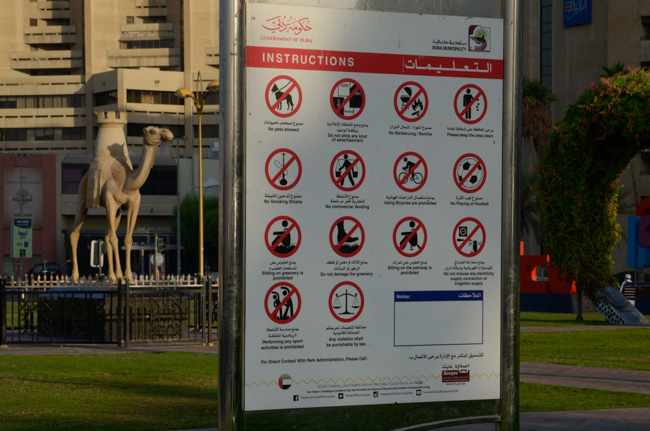
We were amused by the restrictions on enjoying the park. Pretty much everything was prohibited: games, dogs, cycling, exercising, etc. I guess it was OK to walk around as long as you stayed on the paths.
The camel statue in the background commemorated the 27th Chess Olympiad of 1986. I was puzzled by the "castle" on its hump until I saw the dedication plaque -- then it all became clear.
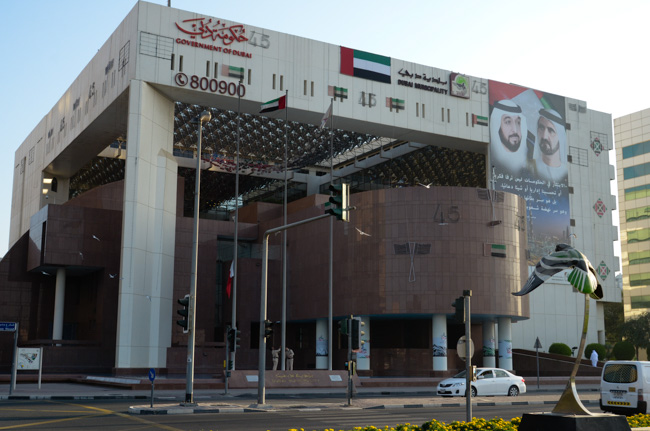
The Dubai "city hall" was across the street from the park.
A pair of soldiers is lowering the flags to half mast. In 2015 the last day of November (1st of December starting in 2019) was designated Martyrs' Day to commemorate those who have fallen in the line of duty. The official name is "Commemoration Day," but the original name remains popular.
Later in the day we observed a moment of silence led by our guides. Then the flags were raised again to full staff.
Although the day is identical in intent to our Memorial Day, I am put off by the term "martyr" and its religious connotation in this context. I expect the name change was to avoid this implication, but the fact that the locals continue to prefer it is unsettling. Islamic "martyrdom," as it has been used in recent years, has sinister overtones.

Our first stop of the day was the Dubai Museum, located in the Al Fahidi fort. The fort, dating from the late 18th century, is the oldest extant building in the city.
One of the exhibits is this traditional house, which is well designed for coping with the region's heat. The tower both captures cooling breezes and expels hot air. Even though this was a hot day without any extraordinary breeze, the space underneath the tower was noticeably cooler than the rest of the house, which was itself cooler than the courtyard surrounding it.
We will see many modern versions of these wind towers later.
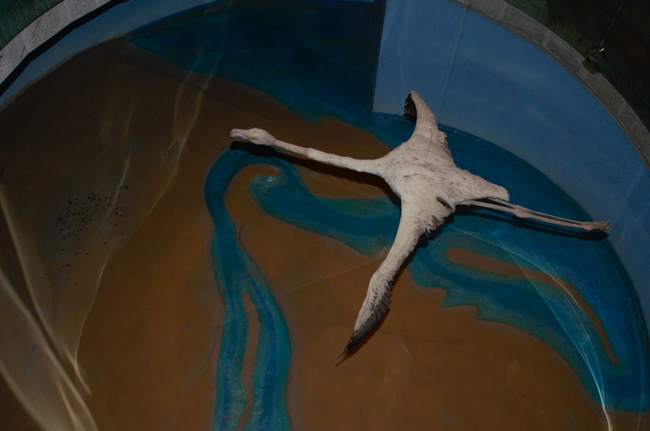
One of the exhibits at the Dubai Museum gives a "bird's eye" view of the creek. Dubai was founded at the crook where the water makes almost a 180° turn.
The bird, by the way, is a flamingo. They are native to the area, but we never visited any of the wildlife sanctuaries. Throughout our travels we saw few birds of any kind.
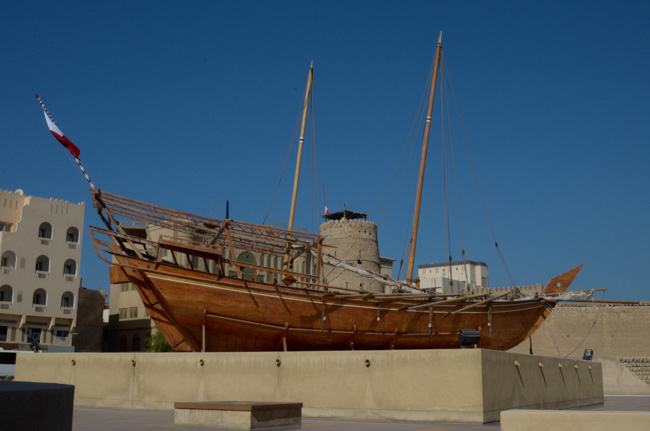
Fishing and pearl diving were the major industries in Dubai for many years. The men would head to sea for months at a time to dive for pearls without the aid of any diving equipment other than nose clips, stone weights and ropes to pull them back to the surface.
The development of cultured pearls in Japan in the early 20th century was the end of the local pearl trade.
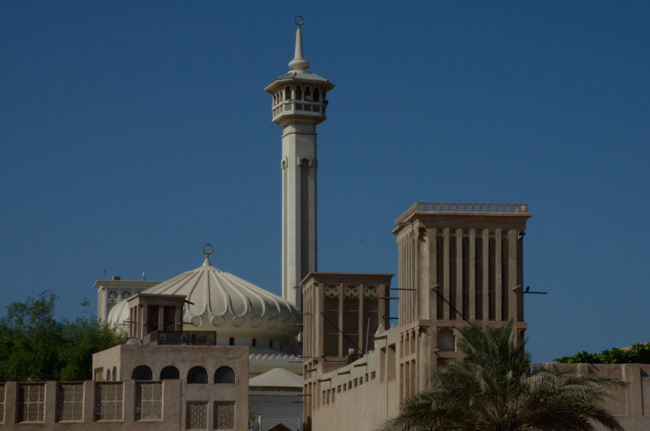
The high point of the first day was our visit to the Sheikh Mohammed bin Rashid al Maktoum Centre for Cultural Understanding. It comprises many original structures from Dubai's early days.
The tallest structure in this image is the minaret of the Diwan mosque. The unusual dome also belongs to it.
The square towers are modern wind towers designed on the same principle as the traditional dwelling shown above. The projecting poles seen in these towers are stylistic only. At one time the people didn't have the technology to trim the poles used to support the internal structure of the towers. This has translated into a modern fashion for bristling poles and they were a feature of almost all the wind towers we saw.
Although only one mosque in Dubai is open to non-Muslims, we were allowed into this one as part of our tour.

This was our first visit to a mosque -- but far from the last!
Our presenter was a local Emirati woman and guide. She was very informative about the local culture and customs. Among other things she explained why women wear black and men white. Since black is a better concealer, the black abayas can be very lightweight and cool. She laughed when we wondered if the layers of clothing were hot. She actually was wearing an extra layer of clothing because it was winter and chilly to her. I guess if you're used to temperatures over 100° then 80° does feel chilly!
She insisted that there was no coercion applied to wear the abaya and hijab, but that she would personally feel exposed out in public with less. Inside her home with family, on the other hand, she wears completely modern clothes.
The camo stole was in honor of Martyrs' Day. All the guides at the cultural center were wearing them.
The lighted sign in the background gives the times of the daily prayers, which vary with the season, sunrise & sunset times, etc.
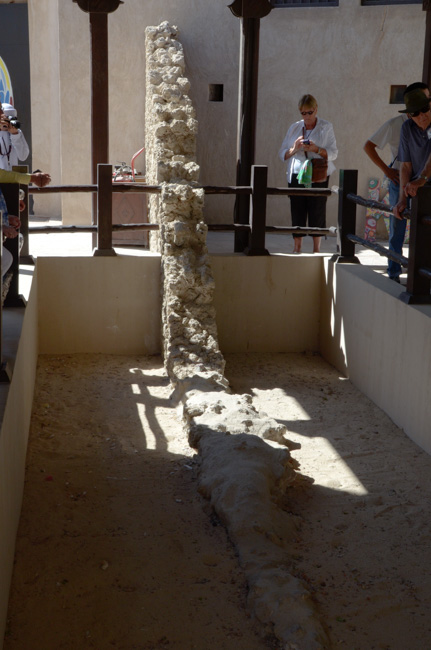
This remnant is all that remains of the old Dubai city wall. The rest has either been demolished or incorporated into newer buildings.
The only original bit here is the foundation. The higher part is a restoration.
The wall, and many buildings of Old Dubai, were constructed of coral stones taken from the adjacent waters. The fossilized corals and shells can easily be seen in places where the stone walls have not been covered with stucco.
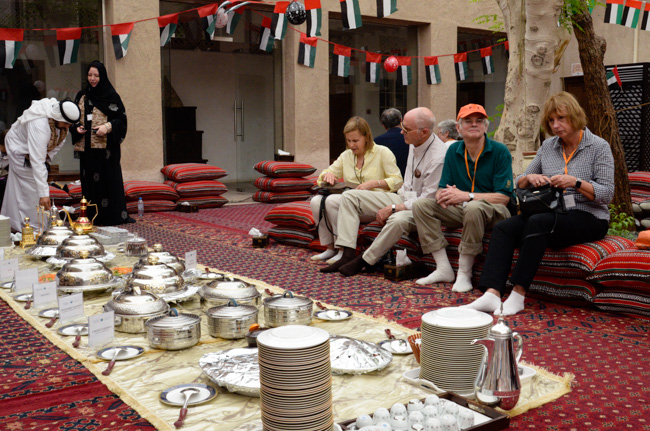
Part of our tour, my favorite part as it happens, was lunch, which was delicious. It included a discussion of eating traditions and also a discussion of the different styles of dress. There are subtle differences in the dishdasha (or thawb) as worn in the various Gulf States and the ghutrah or headdress. (Both of these are known by other names.) The agal, or cord worn around the ghutrah doubles as hobbles for camels or horses.
Emirati men have a long tassel that hangs from the center of the neck of the dishdasha. This tassel is scented. Every person and every household defines a signature scent that is shared with visitors. Omanis have a similar tassel, but it is shorter and worn off the side of the neck. Each nation has its own styles. Check this website for more than you ever wanted to know about traditional Arab and north African clothing styles.
The host demonstrated the traditional way to eat the various dishes with the hand only. He was able to do it very neatly and without spilling even a grain of rice.
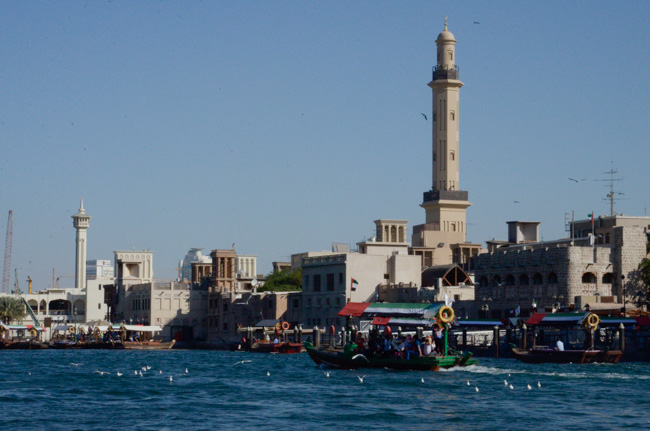
After lunch we clambered onto water taxis to cross the creek to the Dubai souks. The drivers of these boats are slap-dash and we had at least one collision, but no damage.
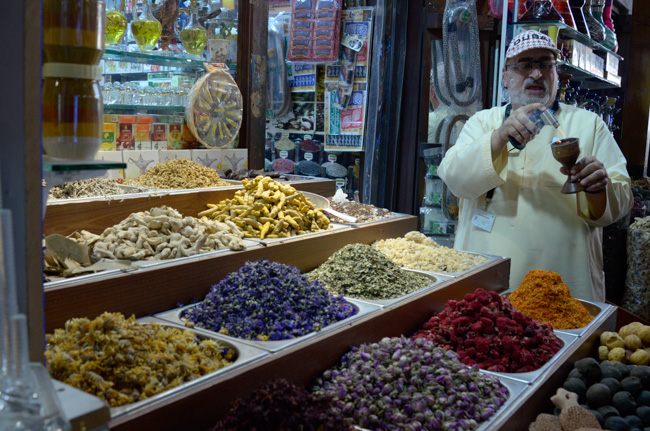
We started in the spice souk. The guide for our group illustrates how the various spices can be used for incense. He fired up a couple of different offerings and some were pretty pungent.
He was himself a Palestinian and wore a different type of robe from the Emirati men. He also favored baseball caps rather than more traditional head coverings. He was quite the talker and our guide in the Cultural Center had to correct him a few times. I once overheard her muttering: "Does he ever shut up?" My response was: "No." She rolled her eyes.
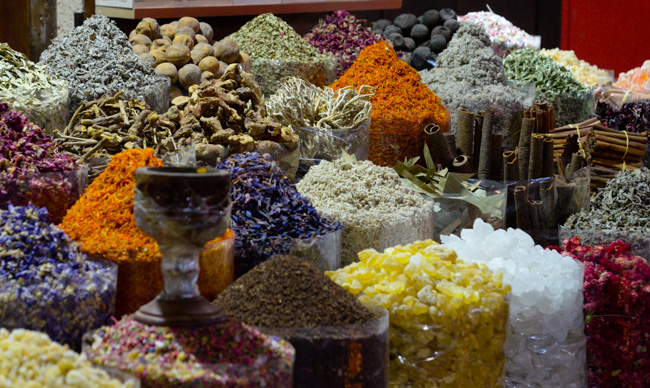
This colorful display at a different shop caught my eye.
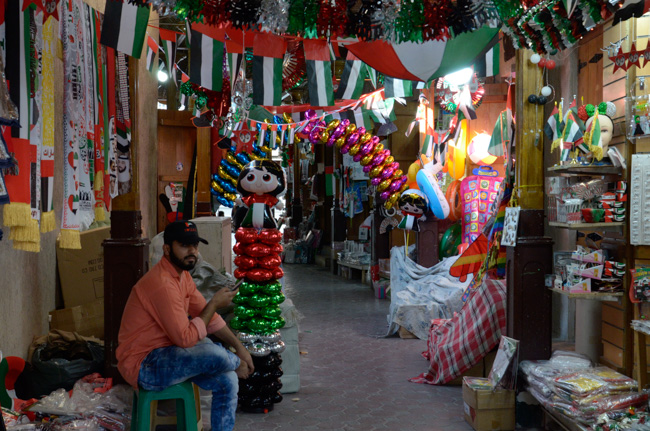
After establishing a meeting point, we were let loose to roam around the souk. The main aisle was filled with tourist goods and it was hard to make a step without being offered a "genuine pashmina shawl." We ducked into the "back alleys" and found goods designed to appeal to the local shoppers. This area specialized in children's toys and clothes.
The UAE National Day, coming up in a couple of days, celebrates the 1971 union of the original six emirates to form the UAE (the seventh was added the following year). This was the 45th anniversary and huge celebrations were planned. That's why the aisle is decorated with the UAE flags and tinsel in the confederation's colors of red, white, green and black.
Unfortunately (or perhaps fortunately) we would leave Dubai before the celebration began and wouldn't arrive in Abu Dhabi until after it was over. I don't know if that scheduling was intentional or not.
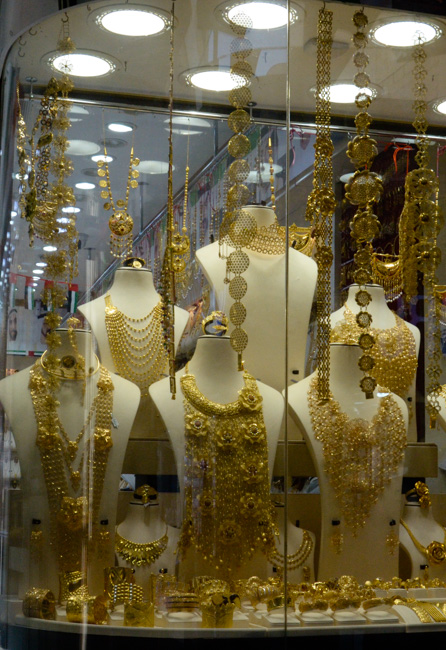
When we came together again, we walked to the nearby Gold Souk. The sellers there were insistent on attracting your attention. One enterprising soul pestered Jim with his offerings. Jim responded, "I don't want any." He finally asked, "well, what DO you want?" Jim said: "Nothing." "I've got nothing!" was the quick retort, delivered with a big grin! Jim still regrets not having cash to give him for such a smart aleck response.
This lavish display was typical of many of the shops. Although the jewelry looks massive, it was flimsy and lightweight. There were also shops that looked more like a typical western jewelry store.
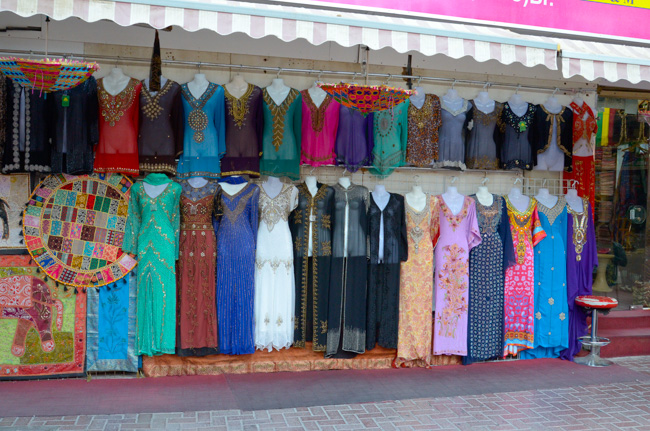
Not all the shops sold gold. We found this store on a side "street" with a display of women's clothes. Most of the dresses and blouses shown are made of transparent fabric. Ooh-la-la, the imagination runs wild thinking of what might be under those black abayas!
At the close of our tour we proceeded to the port to board the Island Sky. Our bags had left for the ship in the morning and were waiting in our rooms.
Click your "back" button to return to the previous page or click for our picture album.